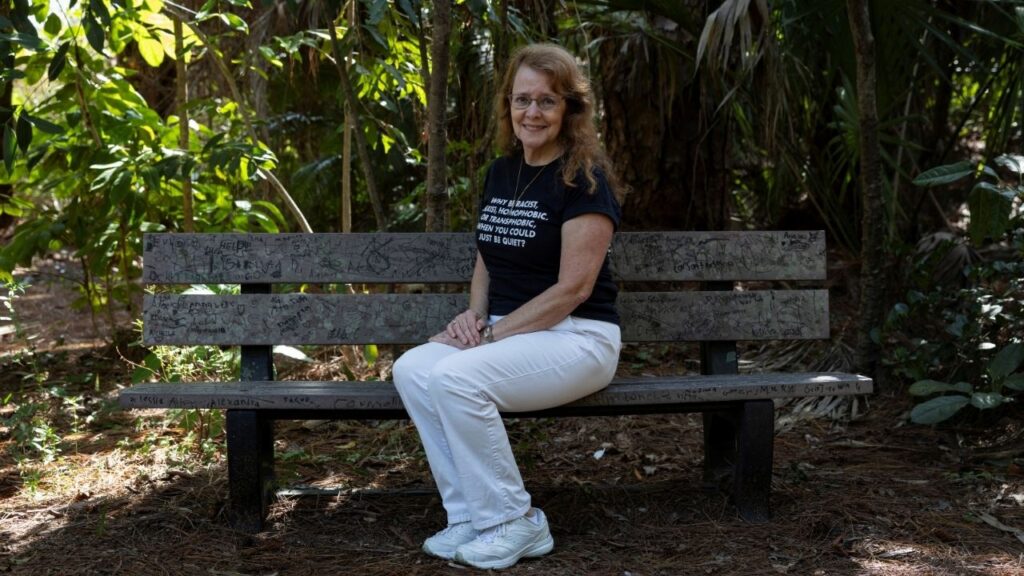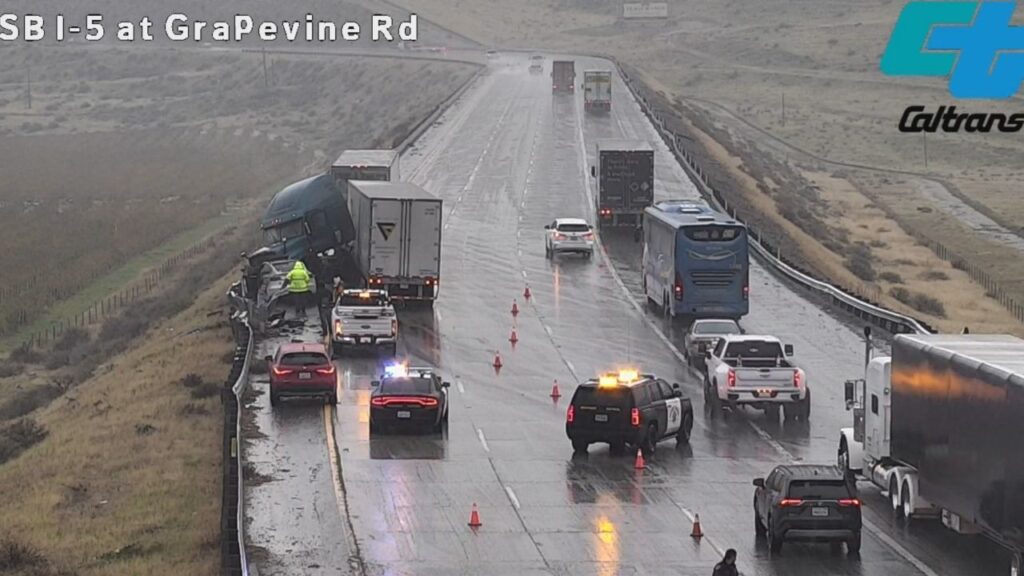The San Jacinto Peak near Palm Springs, Calif., on Dec. 8, 2024. The Cactus to Clouds ascent just outside Palm Springs, Calif., is grueling, but natural treasures, and a speedy trip down, await anyone who is up to the challenge. (Max Whittaker/The New York Times)

- The Cactus to Clouds trail traverses four distinct life zones in a single day, offering hikers a rare journey from desert floor to alpine summit.
- The grueling 10,400-foot elevation gain rivals climbing Mount Everest, with temperatures ranging from scorching desert heat to freezing mountain winds.
- The trail's unique combination of extreme challenge and biodiversity attracts hikers seeking both physical achievement and a chance to experience California's remarkable ecosystems.
Share
|
Getting your Trinity Audio player ready...
|
The steep trail near the top of the Palm Springs Aerial Tramway was covered in inches of spongy fallen needles and peppered with ankle-twisting pine cones. It was also shady, which felt remarkable after the first seven miles of the grueling Cactus to Clouds hike offered little more than a brittlebush leaf’s worth of relief.
I had already hiked up 7,549 vertical feet and still had about 3,000 to go to the top of Mount San Jacinto, a granite crag towering just west of Palm Springs, California.
For this, my third Cactus to Clouds hike, I had chosen a mid-November day, and the conditions were perfect. The 22-mile hike slopes continuously, relentlessly uphill for its first 16 miles, rising from the desert floor to the 10,834-foot summit, then six miles and 2,400 vertical feet down to the top of the tram, culminating in a ride back down that’s well worth the $14 ticket.
I started my trek near the Palm Springs Art Museum at an elevation of 482 feet just after sunrise at 6:41 a.m., carrying enough water to last until the first water source, a ranger station at 8,400 feet, and I had packed several jackets to deal with the wild temperature swings from bottom to top.

People have a variety of reasons to attempt Cactus to Clouds: It’s one of the most biodiverse day hikes in the country. It’s an unusual wilderness experience on the edge of an urban area. But maybe above all, there’s the sheer audacity of the hike. In my previous ascents, each following a significant emotional or physical trauma — diagnosis of multiple sclerosis, divorce, completion of treatment for Stage 3 breast cancer — I was motivated by the idea that committing myself to this challenge would leave me with little energy to feel sorry for myself. And if I made it? Well, that was proof I could handle anything.
This time, my MS was in remission, my marriage was fulfilling, and I had been cancer-free for almost nine years. More than 15 years after my first Cactus to Clouds, it was finally about the landscape instead of about me. I had stashed a pocket guide to the plants of the San Jacinto Mountains, and planned to take time to stop and smell the cedar.
While the full Cactus to Clouds route is only for the supremely fit, you can also hike sections of it. Walk the bottom mile from the trailhead to a picnic area, then turn around. Or ride the tram to its top station and then climb to Mount San Jacinto’s summit and back. You can even trek to the top of the tram then ride it down, saving the summit for the next day, as I did this time because of sudden foot pain. Each offers payoffs like forever views of the Coachella Valley and a chance to spot cactus wrens, Cooper’s hawks and golden eagles.
Mind-Boggling Shapes and Smells
While Mount San Jacinto’s elevation is not remarkable, the difference in altitude from the base to the summit is. The mountain rises about 10,400 vertical feet in approximately six horizontal miles. This steep incline, aside from being almost the equivalent of climbing Mount Everest, accounts for the unusual variety of plant life as it passes through four life zones.
The trail begins among desert species like barrel cactus and creosote, followed by chaparral, scrub oak and manzanita. Then comes a mixed pine forest. At the summit, the trees grow shorter, gnarled by the altitude and the elements, and include limber pine, which flourishes where little else can.
Related Story: ‘Leave It the Way It Is’: Off-Roaders, Hikers React to Proposal to Change 1.4M Acres of Sierra Forest
“The environment and life look very different down in the Colorado-Sonoran Desert than at the top of Mount San Jacinto,” said Melanie Davis, a lead field botanist with the Center for Conservation Biology at the University of California, Riverside, a few days before I hiked. But it’s the in-between zones that are the most interesting, she said. “That’s where there will be the most biodiversity.”
Davis was right. Between 7,000 and 8,000 feet, the color green came in a mind-boggling array of shapes, textures, hues and sizes and with a range of unexpected smells. It was like hiking through a bowl of mixed salad greens: cedar, manzanita, oak and agave, with Jeffrey pines adding just a hint of butterscotch to the air.
Scorching Below, Frigid Above
The conditions that make Cactus to Clouds remarkable also make it dangerous. Hikers on the trail have died from dehydration and exposure. “We get about one fatality a year,” said Eric Holden, a volunteer for Riverside Mountain Rescue, one of four search-and-rescue teams that respond to hikers in distress on the route.
To protect both hikers and rescuers, Mount San Jacinto State Park has closed part of the route under its authority in the summer (triple-digit temperatures at the bottom) and winter (snow and freezing conditions at the top). In 2024, the trail closed in early July and reopened on Nov. 4.
There is little shade for the first 7,000 vertical feet and no water for 10 miles. “One of the biggest killers is hikers who started up realizing they don’t have the physical fitness and turn around,” Holden said. “It might have been cooler when they started at 3 in the morning, but now they’re not feeling good and hiking down into temperatures that could easily be over 100 degrees.”
In the winter, snow can make the trail hard to follow, especially in the 1,000 feet below the top of the tram, and hikers have gotten stranded among the cliffs. I stayed on the path in this section by following a GPS track from a previous Cactus to Clouds hike.

A Challenging ‘Super-Day Hike’
Backpacker magazine calls Cactus to Clouds the fifth-hardest day hike in America. It takes most hikers between 12 and 16 hours. I tried to entertain myself from the unrelenting climb by identifying exactly which species of manzanita was scratching my legs, but that did only so much to distract me. I sat down to rest on a flat boulder 6,000 feet above the trailhead, next to what was either a pink-bracted or green-leaf manzanita.
At least I was hiking uphill. Most seasoned hikers understand that while ascending is hard work, going downhill is downright punishing. In fact, Cactus to Clouds came to exist only because much of the descent takes place on the tram.

On Top of the World
One paradox of Cactus to Clouds: It’s better when there are no clouds. They obscure the views and, sometimes, the trail itself. This ascent also held a different kind of paradox for me. It was the first time I had ever hiked the summit trail separately, yet I felt a surge of pride, because I had listened to my body and spared my sore foot.
Against a panorama of the Pacific Ocean, the shimmering Salton Sea, and the snaggly, sacred Tahquitz Peak, magnificent cauliflower-shaped clouds floated thousands of feet below. With sunset about 90 minutes away, they caught and reflected shades that you would ordinarily see in a scoop of mango ice cream.
Despite the warm oranges radiating across the sky, the summit was freezing, with buffeting wind gusts. I was bundled up in three jackets, including a hooded down puffy coat, and would have gladly accepted another. So as much as I wanted to linger, I wanted even more to avoid frostbite.
I hopped back through the boulders to the trail and pointed myself downhill to the tram, crossing through a cluster of what I identified as bush chinquapin. My pocket guide said its fruits taste like chestnuts. Next time I do Cactus to Clouds, I’ll be sure to stop and give them a try.

If You Go
The trail begins just north of the Palm Springs Art Museum, about 6 1/2 miles from the base of the tram. After the hike, you can use ride-hailing services like Uber and Lyft to get back to the parking lot at the trailhead.
Only the fittest hikers carrying at least 2,000 calories of food and one gallon of water, along with gear for both desert and mountain environments, should attempt the ascent. There are no commercially guided hikes, although there are numerous websites with trip reports as well as downloadable GPS tracks.
Before you go, check with Mount San Jacinto State Park for trail conditions and safety precautions.
—
This article originally appeared in The New York Times.
By Dina Mishev/Max Whittaker
c.2025 The New York Times Company




















